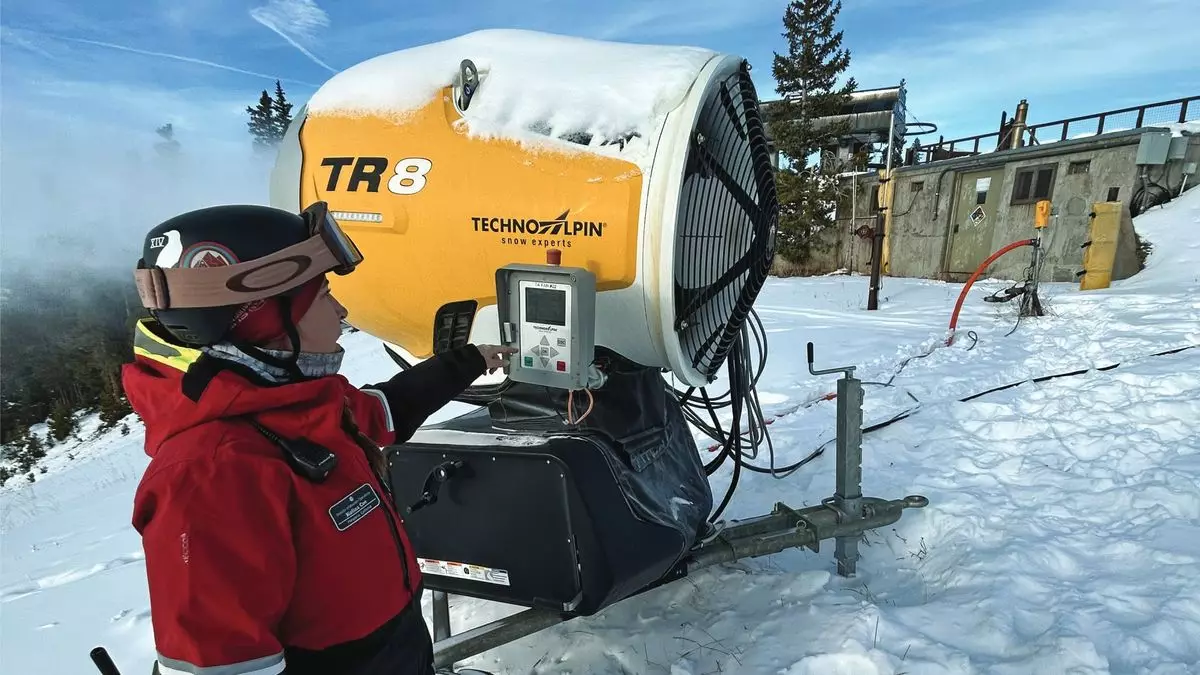As winter approaches, ski resorts across North America are gearing up to welcome enthusiastic skiers and snowboarders. Keystone Resort in Colorado exemplifies the forefront of winter sports technology, particularly in snowmaking, and its ongoing efforts to adapt to climate challenges. The Saturday before Thanksgiving brought a fresh perspective on energy efficiency and innovation at Keystone, as snowmaking operations began in earnest, showcasing their commitment to creating a reliable skiing experience.
At an altitude of 11,640 feet on Dercum Mountain, an impressive snowmaking operation was alive and bustling. Utilizing a state-of-the-art mobile fan gun from the renowned Italian manufacturer TechnoAlpin, water droplets were transformed into snow under carefully monitored conditions. With an air temperature hovering at 32.9 degrees Fahrenheit and an effective wet-bulb temperature of 21.7 degrees due to low humidity, conditions were perfect for snow production. This meticulous approach to snowmaking, as highlighted by resort operations directors Kate Schifani and Kolina Coe, is not just about creating an attractive winter landscape; it’s about ensuring the ski season starts on time, irrespective of changing climate conditions.
In recent years, Colorado ski resorts have faced fluctuating weather patterns that challenge their operations. To combat this, Keystone has made significant investments, recently integrating 53 advanced snowmaking machines into its infrastructure. This initiative, combined with the installation of new water pipes, has propelled the ski area’s opening date forward, now averaging an October 27 start—nearly two weeks earlier than prior seasons. Such improvements not only enhance the guest experience by ensuring earlier access to slopes but also promise extended winter sports availability.
With climate change an ongoing and urgent concern for the skiing community, resorts like Keystone are increasingly focused on sustainability. The resort’s strategic planning revolves around utilizing technology to reduce resource consumption while maximizing snow production. Schifani emphasized how advancements in snowmaking technology enhance efficiency, enabling the resort to produce quality snow using fewer resources. This shift is essential—not only for meeting operational demands but also for adhering to sustainability goals increasingly important among ski resorts globally.
Vail Resorts, which owns Keystone, has pioneered ambitious climate goals, aiming for net-zero operations by 2030. This vision incorporates all aspects of operation, from waste management to energy consumption in snowmaking. They have achieved a remarkable milestone by powering their resorts with 100% renewable electricity for the past two fiscal years, representing a significant step towards environmental responsibility.
A significant aspect of Keystone’s snowmaking efficacy is the implementation of automated systems, which allow for quick adjustments to conditions on the ground. During my visit, the mid-mountain operations center showcased how technology has revolutionized the traditional snowmaking process. Using a sophisticated interface to monitor weather patterns, operators can maximize snow production by quickly activating or deactivating the snow guns based on real-time environmental conditions. This automation drastically reduces the time it takes to prepare for snowmaking—from two hours down to mere minutes—while simultaneously decreasing on-mountain fuel consumption.
Currently, roughly half of Keystone’s snowmaking stations feature automation, with continuous upgrades planned for the future. As a prime example, Vail Mountain’s successful overhaul, which saw an 85% efficiency improvement, serves as a blueprint for Keystone’s ongoing progress. Such advancements not only enhance snow quality and ensure consistency but also promote responsible usage of water and energy, essential factors in maintaining sustainable operations.
The future of skiing at Keystone Resort and similar establishments hinges on the ability to guarantee reliable openings and consistent conditions despite the uncertainties posed by climate change. Schifani articulated a clear vision: ensuring dependable early-season skiing not only boosts guest satisfaction but also strengthens the ski industry’s growth. It is a mutually beneficial arrangement where both resorts and consumers win. By prioritizing innovation and sustainability, Keystone is setting an example for others in the ski community.
As ski resorts like Keystone adapt to meet climate challenges, their embrace of technology will define the future of winter sports. By utilizing automated systems and advancing snowmaking capabilities, they reinforce their commitment to sustainability, ensuring that future generations can also relish the thrill of skiing in a snow-covered wonderland.

